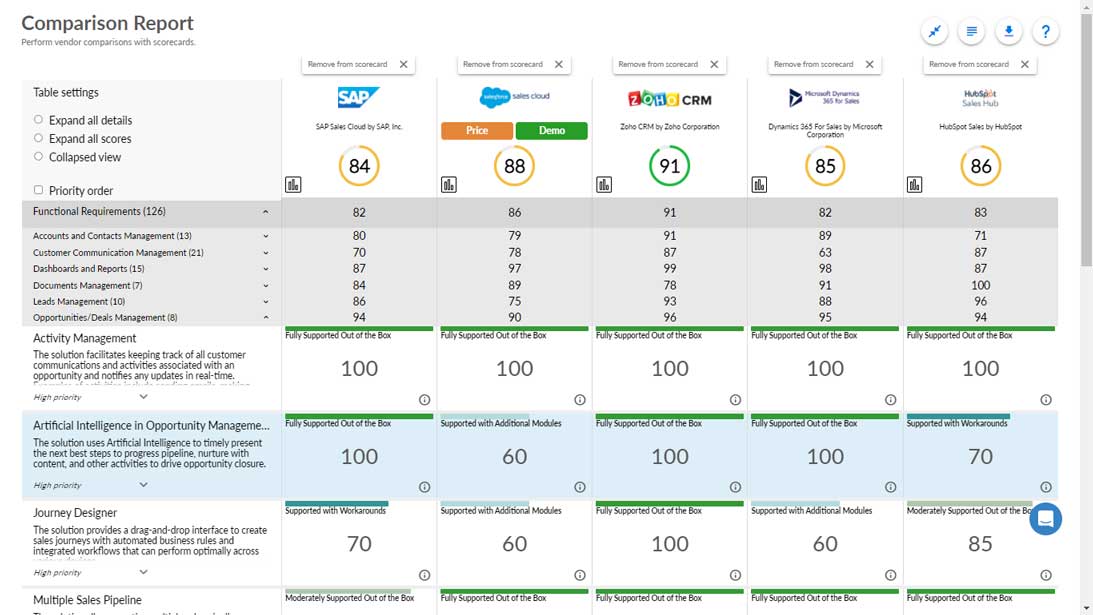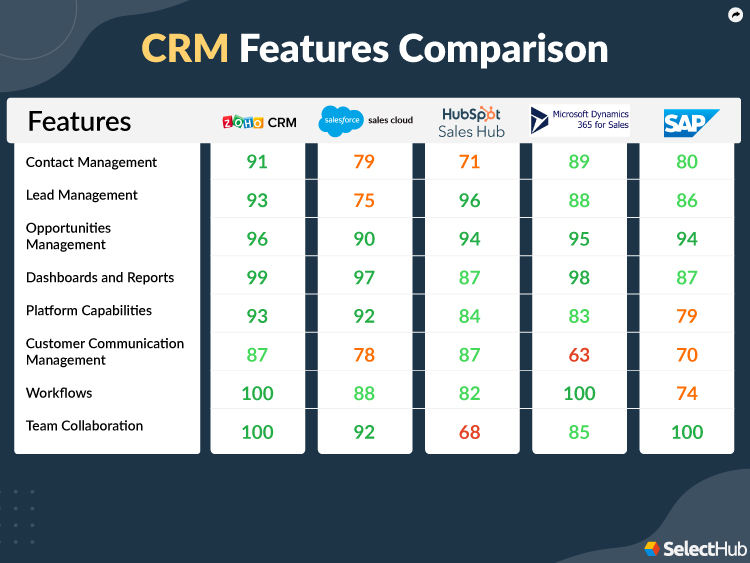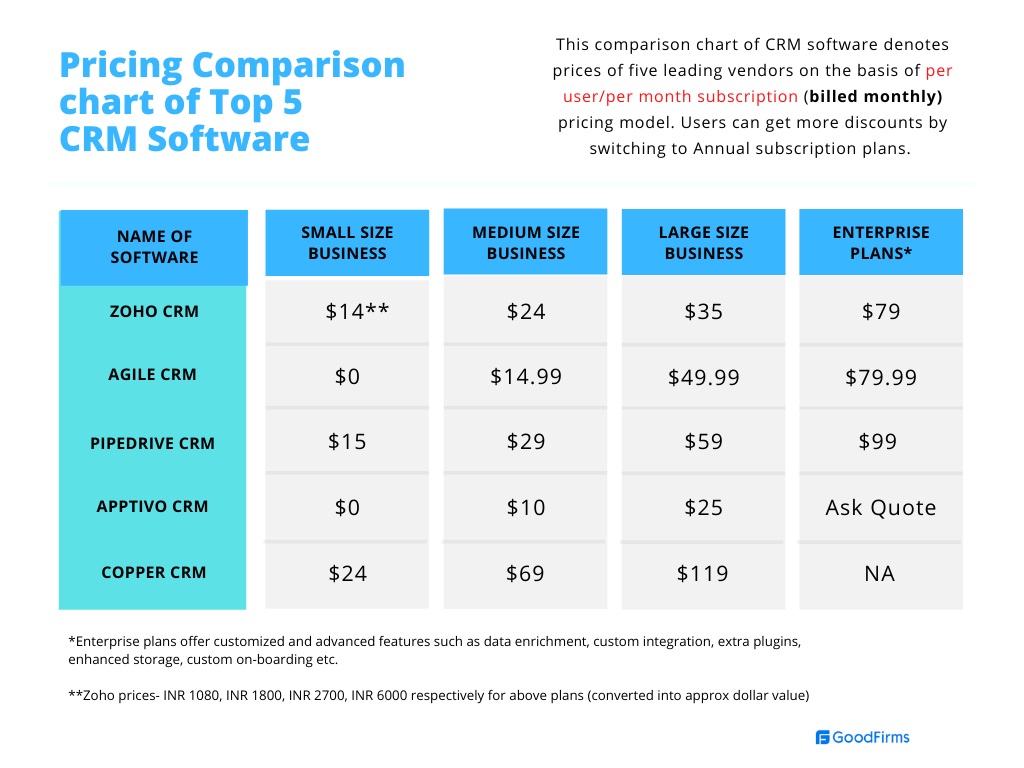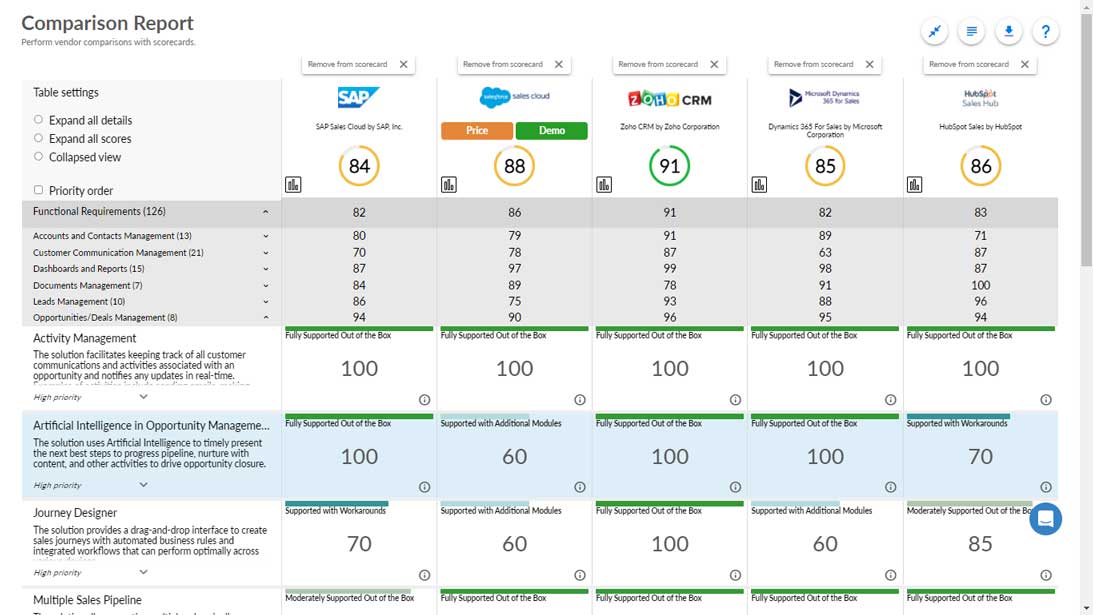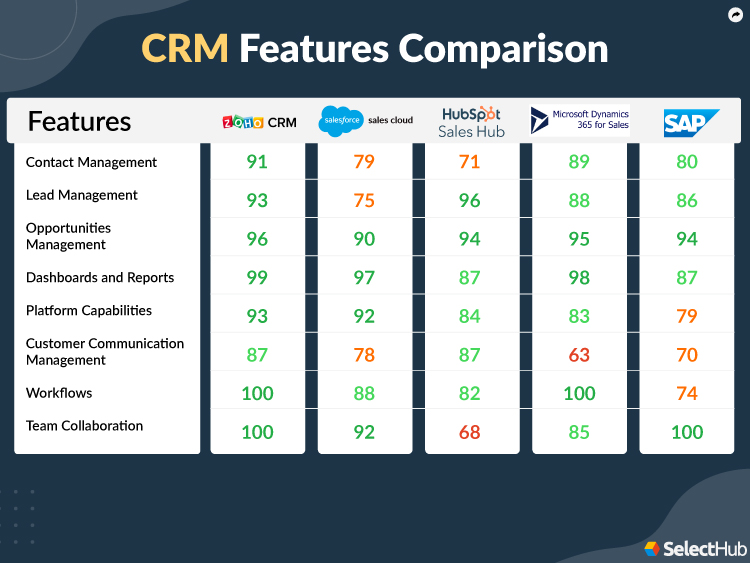CRM Software Pricing Comparison: A Comprehensive Guide opens the door to a world where every dollar you invest in CRM is matched with real, measurable value. Instead of endlessly searching for the perfect fit, this guide cuts through the clutter, offering clarity and insight into how CRM pricing works and what it truly means for your organization’s bottom line.
Understanding CRM pricing structures is essential for organizations of every size. From subscription-based models to freemium options and perpetual licenses, this guide navigates the landscape of CRM costs, explores the factors that influence pricing, and unveils the hidden fees and potential savings. Packed with practical advice and comparative insights, you’ll be equipped to confidently select a CRM plan that aligns with your needs and maximizes your return on investment.
Introduction to CRM Software Pricing Models
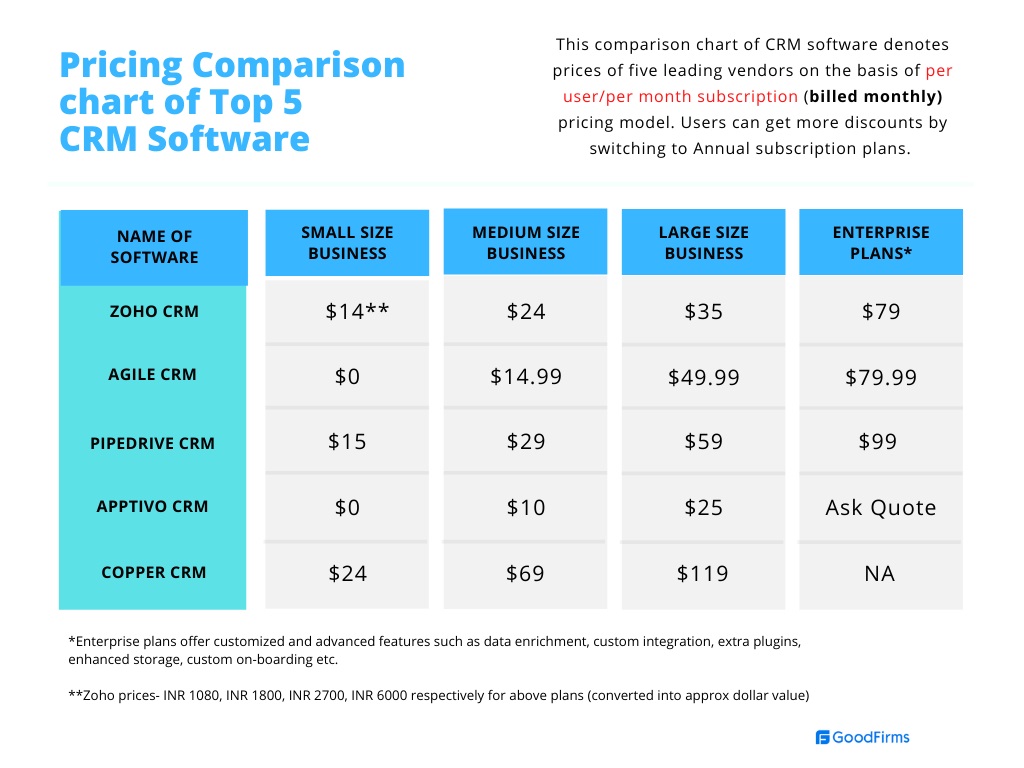
Choosing the right CRM software pricing model is as important as picking your player in a Mario Kart race—one wrong move and you’re left in the dust. Pricing structures can make or break your CRM strategy, especially as companies scale from start-up mode to enterprise giants. Understanding the ins and outs of these models helps businesses align their budgets with their growth ambitions, avoid surprise costs, and maximize their tech investment.
CRM pricing models aren’t a one-size-fits-all game. They come in flavors that suit scrappy entrepreneurs looking for a free ride, seasoned SMBs ready to commit monthly, or enterprise titans going all-in. Each model brings unique pros and cons, and knowing the differences can help avoid pitfalls worthy of a plot twist in a classic sitcom. For businesses, the right pricing approach means predictable cash flow, better resource planning, and the flexibility to upgrade when the time is right.
Overview of Common CRM Pricing Structures
Before diving into the specifics, it’s helpful to set the scene with a rundown of the different pricing models. Each one is designed to cater to different business needs, budget sizes, and growth stages. They can drastically influence the total cost of ownership, update cycles, and long-term flexibility.
- Subscription-Based Pricing: The Netflix of CRM models, charging monthly or yearly fees per user. Popular with cloud-based platforms like Salesforce and HubSpot, this model offers regular updates, support, and scalability. Ideal for businesses wanting low upfront costs and predictable expenses.
- Perpetual License: The classic “buy once, own forever” deal, like buying a DVD box set. Companies pay a one-time fee for lifetime software access, often paired with optional annual support or upgrade fees. Microsoft Dynamics and legacy on-premises solutions are famous for this structure, which works well for organizations prioritizing ownership and long-term value over ongoing payments.
- Freemium Model: Think of it as the Spotify free tier—core features at no cost, but premium capabilities come at a price. Zoho CRM and Agile CRM use this model, allowing small teams to start free and upgrade as needs grow. It’s a low-risk entry point for startups or solo operators.
- Usage-Based Pricing: Like your cell plan, you pay for what you use. Charges might be based on contacts, emails sent, or API calls. This model is often seen in add-ons or marketing automation features within CRMs, such as ActiveCampaign or Freshsales. It favors companies with fluctuating needs or seasonal demand spikes.
Impact of CRM Pricing Structures on Different Business Sizes
The way pricing is structured can feel like the difference between sharing a pizza with friends or going solo with a supersized meal. For small businesses, cash flow is king, so flexibility and predictable costs are crucial. Larger enterprises need customization, integration, and long-term stability, sometimes willing to pay more upfront for control and compliance.
- Small Businesses and Startups: Subscription-based and freemium models let these companies test the waters without draining budgets. The ability to add or remove users at will is a lifesaver during rapid pivots or growth spurts, much like bootstrapping a garage band before going mainstream.
- Mid-Sized Companies: With more complex needs, these organizations often blend subscription features with premium add-ons or usage-based components. They benefit from models that allow scaling without steep upfront investments—a bit like unlocking downloadable content in a video game as you level up.
- Large Enterprises: Perpetual licenses can appeal to big players who want full control over data and infrastructure, often investing in customizations and integrations. They may prefer predictable, long-term costs and the ability to tailor the system, similar to owning a blockbuster franchise instead of renting a movie.
“Subscription-based pricing gives businesses the superpower of predictable expenses, while perpetual licenses offer control and lifetime value—choose your hero wisely.”
Key Factors Influencing CRM Software Pricing: CRM Software Pricing Comparison: A Comprehensive Guide
Just like assembling your own superhero team in the Marvel Cinematic Universe, building the perfect CRM setup comes with a range of price points—each influenced by what powers (features) you need, how many heroes (users) you have, and which universes (tools and platforms) you need to connect. CRM pricing models aren’t one-size-fits-all; understanding the factors that push the cost up or down is crucial for choosing a platform that matches your business needs and budget.
CRM vendors use several criteria to determine pricing. These often include the range of features, the number of users, customization capabilities, integration with other software, scalability for future growth, and the scope of ongoing support services. Each of these factors can have a significant impact on your final bill, much like adding extra toppings to a pizza or DLC to a video game console. The deeper you dig into customizations or seek enterprise-level scalability, the more likely it is that your costs will rise—sometimes considerably.
Influence of Features and User Licenses
The number of features bundled with your CRM is a major cost driver. Basic plans often include contact management and pipeline tracking, while premium packages might throw in automation, AI analytics worthy of Tony Stark’s Jarvis, or advanced reporting. Similarly, CRM pricing frequently scales with the number of users—think of it like paying for concert tickets: the more friends you invite, the higher the bill.
- Feature-rich plans with automation, AI insights, and sales forecasting can cost two to three times more than basic offerings.
- Per-user pricing is the norm for cloud-based CRM systems like Salesforce, HubSpot, or Zoho CRM. For example, Salesforce Essentials starts at around $25 per user per month, but advanced tiers can exceed $150 per user per month.
“The more you customize and expand, the more you pay—just like upgrading to VIP at a Comic-Con event.”
Impact of Integration and Customization Options
Integrating your CRM with other tools, such as email marketing platforms, accounting software, or e-commerce systems, can significantly influence the final cost. While some integrations come standard, others—especially custom-built connectors or deep API access—may incur additional charges. Customization also plays a starring role; unique workflows, custom dashboards, or branded modules often require professional services from the vendor or certified partners.
- Connecting CRM with platforms like Mailchimp, QuickBooks, or Shopify may be included in mid-tier plans but might require premium subscriptions or one-time setup fees for complex integrations.
- Bespoke customizations, like adding a custom object in Salesforce or building a unique sales process in Microsoft Dynamics 365, can add thousands of dollars to your annual costs.
Effect of Scalability on Long-Term Budget
A CRM solution that grows with your business is essential for avoiding the need to switch tools down the road, much like upgrading from a starter Pokédex to a full-featured one. However, scalability comes with its own set of costs. Some vendors offer discounts as your user count increases or if you commit to multi-year contracts, but advanced scalability features—such as sandbox environments, multi-region support, or robust API call limits—can significantly push up prices.
- Enterprise-level scalability in platforms like Oracle NetSuite CRM or SAP often comes bundled with advanced security, unlimited storage, and priority support, but entry costs may start at $100/user per month or require custom quotes.
- Some platforms charge extra for advanced administration, data storage, or performance monitoring as your database grows.
Additional Services Impacting Overall Pricing, CRM Software Pricing Comparison: A Comprehensive Guide
Beyond the sticker price for licenses and modules, a variety of extra services can influence your total CRM investment. These services are typically optional, but choosing them can mean the difference between a smooth rollout and a bumpy ride worthy of a Fast & Furious chase.
Before making a decision, consider how these services could affect your total cost of ownership:
- Onboarding and implementation support—vendor-led setup or migration from legacy systems
- Ongoing technical support (24/7 vs. business hours)
- User training sessions or custom educational materials
- Data migration services—especially when moving from old systems or spreadsheets
- Advanced analytics or business intelligence add-ons
- Dedicated account management or premium support levels
- Mobile app customization or offline access features
- Compliance certifications (like HIPAA, GDPR) for regulated industries
“Hidden costs often lurk in onboarding, customization, and premium support—always check the fine print, just like reading the terms before streaming a new season on your favorite platform.”
Comparative HTML Table of Leading CRM Software Pricing Plans
Looking to avoid the “Ross and Rachel” break-ups with your customers? Choosing the right CRM makes all the difference, but navigating the pricing jungle can feel like you’re deciphering the Matrix. Here’s a clear and concise comparison table spotlighting leading CRM platforms—so you can focus more on building relationships and less on crunching numbers.
A responsive HTML table is essential for today’s device-hopping world. Whether you’re plotting strategy on your laptop, catching up on your phone at Central Perk, or revisiting details on a tablet, this table keeps things clear and accessible. Below, you’ll find a breakdown of top CRM options, ranging from entry-level to power-user tiers, plus key features to help you spot what each plan brings to the table—no decoder ring required.
CRM Software Pricing Plans and Core Inclusions
The following table summarizes the pricing and core inclusions for some of the most notable CRM platforms—think of it as your “Avengers Assemble” lineup for business growth. The data below is based on information published by each provider as of early 2024. Pricing may vary based on region, contract length, or user count, so treat these as your launchpad for further research.
| CRM Name | Pricing Tier | Monthly Cost (per user) | Notable Inclusions |
|---|---|---|---|
| Salesforce Sales Cloud | Professional | $75 | Lead & opportunity management, customizable reports, integrations, workflow automation |
| HubSpot CRM | Starter | $18 | Contact management, email tracking, deal pipelines, basic automation |
| Zoho CRM | Enterprise | $40 | Advanced analytics, multi-channel communication, AI assistant, custom modules |
| Pipedrive | Advanced | $39.90 | Smart automation, email templates, workflow builder, goal tracking |
“Comparing CRM software pricing plans is like assembling a dream team—each member brings unique strengths. The right choice depends on your mission, your budget, and the features that matter most for your company’s next big win.”
A table like this can be styled for mobile-friendliness using CSS, such as by making the table scrollable or stacking columns vertically for small screens. Visually, you might picture a sleek dashboard: the table adapts gracefully whether displayed on a laptop, tablet, or smartphone, with clear differentiation between rows and highlighted headings for at-a-glance scanning.
To sum it up, this comparative pricing breakdown helps you cut through the noise—no need to rely on “The Force” to make the best CRM call for your business.
Hidden Costs and Additional Fees to Consider

For businesses diving into CRM software, the sticker price can be as deceptive as a Hollywood movie trailer—what you see isn’t always what you get. While base prices often headline marketing materials, there’s a whole lineup of hidden costs waiting behind the scenes. These extra fees can sneak up on you like a post-credits plot twist, and if you’re not careful, they can turn your CRM investment into a blockbuster budget buster.
Total cost of ownership isn’t just the monthly subscription fee. Many CRM platforms lure you in with affordable entry points, but once you start adding users, integrating other tools, or requesting support faster than The Flash, costs can spiral. Understanding these less-visible charges helps you avoid budget surprises worthy of an episode of “Stranger Things”—because nobody likes monsters hiding in their pricing plans.
Common Hidden Fees in CRM Software
Hidden fees often fly under the radar in pricing brochures. They show up later, sometimes when you need to scale or access a must-have feature. These costs can include everything from basic onboarding to accessing advanced APIs—sometimes even just for picking up the phone to call support.
- Onboarding and Training: Many CRM vendors charge for initial setup and training. For example, Salesforce offers guided implementation packages that can cost thousands, especially for mid-size or enterprise customers. This is like paying for a VIP movie screening just to learn how the theater works.
- Data Migration: Moving your existing customer and sales data into a new CRM isn’t always free. Companies like HubSpot may include limited migration in higher tiers, but more complex imports (like from legacy databases or custom fields) often require a paid service, which can range from a few hundred to several thousand dollars.
- Premium Support: Basic support may only get you email responses or slow ticket resolution. For phone support, priority access, or a dedicated account manager, expect extra charges—think Zendesk-style tiered support where only the top plans get the red-carpet treatment.
- API Access and Integrations: Some CRMs restrict access to APIs or integrations unless you’re on a higher-priced plan. Pipedrive, for instance, limits advanced integrations to premium subscriptions, so your grand plans for connecting every app in your stack can get expensive fast.
- Storage and Contact Limits: If you start out with a modest list and suddenly go viral like a Super Bowl commercial, be wary: many CRMs charge for extra contacts, file storage, or record expansions. Mailchimp’s CRM, for example, charges per contact above its included limits.
- Advanced Features and Add-ons: Basic plans often exclude must-have features, such as campaign management, in-depth analytics, or workflow automations. Upgrading for these can feel like paying for every piece of “DLC” content in a video game.
- User Licenses and Seat Upgrades: Adding new users often isn’t pro-rated and can only be done at the next billing cycle—so when your team grows faster than the cast of “Fast & Furious,” be ready for the bill to keep pace.
“Always read the fine print—CRM pricing is like a streaming service subscription: if you want all the best content, the monthly fee is just the beginning.”
Impact of Hidden Fees on Total Cost of Ownership
These hidden costs can quietly add up, transforming an initially affordable CRM into a high-maintenance habit. When budgeting, companies should calculate expected costs over a 12-month or 24-month period, factoring in possible team growth, evolving support needs, and future plans for integrations or analytics expansion. Remember, Netflix started at $7.99—now most people pay for multiple tiers and features, so apply the same thinking to your CRM.
- If onboarding and training run $2,000 upfront, and premium support adds $100/month, that’s $3,200 extra in the first year alone.
- Scaling from 10 to 30 users or increasing your contacts from 1,000 to 10,000 may double or triple your annual spend, even if your base subscription stays the same.
- Integrations that start free may later require “connector” subscriptions or custom API work, which can introduce new monthly or one-time fees.
Savvy buyers map out their likely future needs, then request all-in quotes—including migration, support, integrations, and seat upgrades—before signing the dotted line.
Feature Set Comparison Across Price Tiers
CRM software pricing tiers often resemble streaming service packages—think of choosing between Netflix Basic and Netflix Premium. At each tier, the core experience is present, but the extras and exclusives are reserved for those willing to pay more. Understanding how leading CRM vendors stack their features helps businesses avoid surprises worthy of a season cliffhanger.
The most popular CRM platforms, including Salesforce, HubSpot, Zoho CRM, Pipedrive, and Microsoft Dynamics 365, bundle their tools in ways that can make or break your workflow. Most providers reserve advanced analytics, deep automation, and premium support for higher-priced plans, while entry-level options offer essential contact and deal management. Here’s how these feature sets compare when you climb the pricing ladder.
Core and Advanced Features in CRM Pricing Tiers
Below is a detailed side-by-side table comparing basic and advanced features, as well as notable limitations, of leading CRMs across their respective pricing tiers. This breakdown highlights which capabilities are typically locked behind paywalls.
| CRM | Basic Features | Advanced Features | Limitations |
|---|---|---|---|
| Salesforce |
|
|
|
| HubSpot CRM |
|
|
|
| Zoho CRM |
|
|
|
| Pipedrive |
|
|
|
| Microsoft Dynamics 365 |
|
|
|
Features such as advanced workflow automation, AI-powered insights, deep analytics, and premium support are almost always reserved for higher-priced CRM subscription plans.
For example, Salesforce’s renowned Einstein AI is exclusive to upper-tier subscriptions, enabling predictive analytics and lead scoring that smaller teams may never see without a budget bump. Similarly, HubSpot’s robust sales automation and custom reporting are locked behind professional and enterprise plans, mirroring how exclusive backstage passes work at a major concert—basic ticket holders can attend, but only VIPs get the extras.
Recognizing these boundaries isn’t just about budget—it’s about aligning your team’s capabilities and growth trajectory with the platform’s unlockable features. Choosing the right tier means deciding if you want to livestream the basics or if your business is ready for the director’s cut.
Cost-Benefit Analysis for Small, Medium, and Large Businesses
Every business, from a startup working out of a garage to a Fortune 500 giant, faces the pivotal decision of selecting the right CRM pricing plan. The stakes? Maximizing operational value while keeping costs in check. This section unpacks how companies of all sizes can navigate CRM pricing models to find the sweet spot between affordability and capability—think of it like choosing between Netflix’s Basic, Standard, or Premium: there’s a plan for everyone, but the perks and price tags vary dramatically.
CRM pricing models aren’t one-size-fits-all. Small businesses often need budget-friendly simplicity, while mid-market companies chase scalable features, and enterprise players demand robust integrations and ironclad support. Understanding the trade-offs at each tier helps your business channel its inner Tony Stark—balancing power, flexibility, and cost-effectiveness, no matter how big or small the mission.
Evaluating CRM Value for Small Businesses
For small businesses, especially startups and mom-and-pop shops, the focus is on essentials without overspending. Choosing a CRM with just the right features prevents unnecessary costs and complexity, much like selecting a Spotify plan that doesn’t load you up with playlists you’ll never play. Here’s how small businesses can get the most bang for their buck:
- Start with free or entry-level plans from reputable providers like HubSpot CRM or Zoho CRM, which offer core contact management and deal tracking at little to no cost.
- Opt for solutions that grow with your business, such as Monday.com or Freshsales, which allow seamless upgrades as your customer base expands.
- Focus on automation features that save manual effort—think automated follow-ups or lead categorization—without splurging on advanced analytics or integrations you won’t use right away.
- Ensure mobile access is included, so you can keep up with customers on the go, just like checking your Instagram feed from anywhere.
“Small businesses should avoid feature overload—pay for what you’ll actually use to keep costs lean and workflows clean.”
While entry-level plans are wallet-friendly, they may lack customization and advanced reporting. Upgrading too soon can spike costs without proportional value, so it’s best to stick with basics until your needs evolve.
Assessing CRM Investments for Medium-Sized Businesses
Medium-sized companies, like fast-growing tech startups or regional retailers, have outgrown basic plans but don’t need the massive muscle of enterprise solutions. The right CRM plan at this level can fuel sales growth, streamline workflows, and power up marketing, all without busting the budget. Here’s what mid-market businesses should look for:
- Prioritize plans with automation, pipeline customization, and integration with popular tools like Slack, QuickBooks, or Mailchimp.
- Look for user-based pricing that matches your team size, as many providers (e.g., Salesforce Essentials, Pipedrive) charge per seat rather than a flat fee.
- Take advantage of advanced analytics and reporting features, which can help drive smarter business decisions as your company scales.
- Consider platforms with strong customer support and onboarding help, minimizing downtime during adoption.
“Invest in functionality that directly impacts sales productivity and customer experience, but avoid overpaying for modules you won’t deploy within the next 12 months.”
Choosing a mid-tier plan delivers more muscle—think workflow automation and deeper reporting—but usually at a higher per-user cost. It’s a balancing act: overspending can eat into margins, while underspending risks stalling growth if the CRM can’t keep up with your expanding team and data needs.
Optimizing CRM Expenditure for Large Enterprises
For large enterprises—think like the Avengers of business operations—CRM solutions must handle massive data volumes, complex workflows, and global teams. Investment at this level is significant, but so are the efficiency gains. Here’s how to achieve maximum ROI:
- Select enterprise-grade CRMs like Salesforce, Microsoft Dynamics 365, or SAP, which offer advanced security, customization, API integrations, and multi-currency support.
- Negotiate custom contracts to secure volume discounts, premium support, and tailored onboarding—major vendors expect this, and it pays off at scale.
- Prioritize systems that support role-based access, regulatory compliance (e.g., GDPR), and integrations with legacy platforms or industry-specific apps.
- Invest in training and change management to ensure high adoption rates, squeezing full value from every feature.
“At the enterprise level, the cost of a robust CRM is offset by improved productivity, global visibility, and data-driven decision-making—provided the platform is fully leveraged.”
Enterprise plans typically carry the heftiest price tags, but deliver unmatched flexibility and support. The main trade-off is complexity: with great power comes greater implementation costs and longer onboarding, so a clear rollout roadmap is essential to avoid wasted resources.
Tips for Negotiating CRM Software Pricing
In the world of CRM software, the sticker price is rarely the final word. Much like a classic car dealership in a Hollywood blockbuster, there’s almost always room to haggle, score some extras, or at least secure terms that better fit your business needs. Whether you’re a scrappy startup channeling Silicon Valley vibes or a seasoned enterprise reminiscent of a Wall Street boardroom, understanding how to negotiate with CRM vendors can help you maximize value and avoid common pitfalls.
Securing the best deal is about more than just slashing numbers off the monthly bill. Effective negotiation involves understanding what really matters to your business, leveraging market intelligence, and knowing which value-added perks you can request to boost your ROI. Vendors are often open to sweetening the pot with additional services or flexible terms, especially when you approach the conversation with confidence and data in hand.
Common Value-Added Services Included in CRM Negotiations
Beyond the base price, CRM vendors can offer a range of valuable add-ons during the negotiation process. These extras can significantly enhance your user experience, support your rollout, or future-proof your investment by making upgrades and integrations easier.
Extended free trial periods, premium onboarding, and inclusion of customer support tiers are just a few examples. For instance, Salesforce is known for offering extended implementation support for enterprise clients, while HubSpot sometimes includes marketing automation features during key promotional periods for new customers.
- Extended trial periods: Allowing your team to conduct in-depth testing with live data before committing.
- Premium onboarding or training: Access to expert-led sessions to fast-track adoption and maximize feature usage.
- Higher support tiers: Enhanced customer support, including 24/7 assistance or dedicated account managers.
- Discounted or free integration services: Assistance connecting CRM with your existing tech stack, reducing hidden costs.
- Future feature upgrades: Locked-in pricing for upcoming modules or enhanced features.
“Negotiation is the art of letting the other side have your way.” — adapted from the playbook of classic Hollywood negotiators.
Negotiation Tactics for Better CRM Software Deals
Approaching CRM negotiations with a clear strategy can put you in the driver’s seat—think of it as assembling your own Ocean’s Eleven crew to tackle vendor pricing. Each tactic below is used by successful businesses to get more from their CRM investments, often securing deals that include both cost savings and valuable extras.
Before diving into negotiations, gather intel on competitor pricing, identify must-have features, and clarify your budget constraints. Armed with this information, you’ll be able to steer conversations with confidence and push for the terms that matter most.
- Leverage competitive quotes: Share quotes from rival CRM vendors to encourage price matching or improved terms.
- Bundle services: Request bundled discounts if you commit to multiple modules, users, or longer contract terms.
- Ask for annual payment discounts: Vendors often provide significant savings for annual prepayment versus monthly billing.
- Negotiate renewal terms upfront: Lock in favorable rates or upgrade conditions before signing the first contract to avoid surprises later.
- Request value-added extras: Secure training, support, or integration services at reduced or no extra cost.
- Highlight your business’s potential: Emphasize your expected growth and future needs—vendors may offer better terms in hopes of a long-term relationship.
- Use timing to your advantage: End-of-quarter or end-of-year negotiations often yield better deals as vendors race to hit sales quotas.
“Think of your CRM contract like a director’s cut—there’s always extra footage (or features) waiting to be unlocked if you know where to look.”
Long-Term Value and ROI Considerations
Grabbing that shiny new CRM software can feel like upgrading to the latest iPhone—super sleek, promising, and ready to change the game. But smart businesses look beyond the initial hype, focusing on the long-term value and the actual return on investment (ROI) the system will deliver after the honeymoon phase. Evaluating CRM pricing isn’t just about sticker price; it’s about understanding true cost over several years and matching paid features to real business gains.
Total Cost of Ownership Over Multiple Years
Looking at CRM software as a marathon, not a sprint, helps businesses avoid being blindsided by costs down the road. The total cost of ownership (TCO) includes way more than the advertised monthly fee, factoring in setup, training, integrations, upgrades, and even the time your team spends getting up to speed. Ignoring these can turn a great deal into a budget buster.
Before jumping in, businesses should map out all expected expenses over a typical contract period (often three to five years for cloud solutions). This provides a crystal-clear picture of the real financial commitment. Key elements include:
- Recurring subscription fees (monthly/annual)
- Onboarding and implementation costs
- Training sessions for staff and new hires
- Customization or integration with other apps (like email or e-commerce platforms)
- System upgrades or feature expansions
- Potential downtime or productivity dips during transitions
Calculating TCO shows whether a CRM remains budget-friendly over time or turns into the software equivalent of buying a used car that’s always in the shop.
ROI Calculation: Balancing Feature Utilization and Pricing
To justify any CRM investment, businesses need to see measurable returns. ROI from CRM isn’t just about sales increases—it’s about operational efficiency, improved customer relationships, and better data-driven decisions. Calculating ROI involves not only the raw numbers, but also the impact of actual feature usage.
The basic formula often used is:
ROI (%) = [(Net Benefits from CRM – Total Cost of Ownership) ÷ Total Cost of Ownership] × 100
Example: If a company spends $10,000 on CRM in a year and directly attributes $30,000 in new revenue and cost savings to CRM, the ROI would be
[(30,000 – 10,000) ÷ 10,000] × 100 = 200%
It’s critical to match the CRM’s feature set to your actual workflow. For example, don’t pay extra for advanced marketing automation if your team only uses basic contact management. The best ROI comes when every dollar spent delivers a feature that your team actively uses to drive growth or efficiency.
Illustrative Scenario: Achieving ROI from CRM Investment
Businesses can learn a lot by seeing how others have made CRM work for them. Here’s a snapshot, inspired by real-world results from a mid-sized retail brand:
BrightLights Apparel, a midsize retailer in Los Angeles, invested $18,000 over two years in a CRM platform that integrated sales, marketing, and customer service. After streamlining their lead management and automating follow-up emails, the team saw sales cycle times drop by 30% and customer retention improve by 20%. The company calculated that these changes drove an additional $60,000 in annual revenue and saved $10,000 in administrative costs. Factoring in software, training, and integration expenses, BrightLights reported a 288% ROI—transforming their CRM from a line-item expense to a growth engine.
This scenario illustrates the importance of evaluating not just upfront costs, but how strategic CRM adoption can pay dividends in efficiency, customer loyalty, and the bottom line—making the long-term investment well worth it for businesses ready to play the long game.
Free vs. Paid CRM Solutions
The world of CRM software can feel a bit like choosing between the free version of a game app and the paid “Premium” unlock. Free CRM tools tempt with zero cost and easy signup, but often come with restrictions that might be a dealbreaker as your business ambitions grow. Paid solutions, on the other hand, open up a world of extra features, support, and muscle, but with a monthly or annual fee attached. Let’s break down exactly what you can expect when weighing free versus paid CRM platforms, using relatable comparisons and real-world pop culture analogies to keep things crystal clear.
When assessing CRM options, companies need to look beyond just the price tag and consider what’s truly essential for their workflow. Free plans are like demo versions: great for getting a taste, but often limited in customization, integrations, and scalability. Paid plans, meanwhile, are more like a VIP backstage pass—unlocking advanced features, deeper analytics, and robust support. The key is knowing when to level up.
Key Differences in Support, Integrations, and Scalability
The most significant contrasts between free and paid CRM tools show up when you dig into user support, integration capabilities, and the ability to scale as your team or data grows. Here’s a breakdown to help visualize where the lines are drawn:
Businesses can use this list to evaluate if their current CRM setup is holding them back or if sticking with a free option still fits their needs. Consider the following typical differences:
-
Customer Support:
Free versions often offer only community forums or self-help articles, while paid options provide access to live chat, email, or even 24/7 phone support. For example, HubSpot’s free plan has basic ticketing, while their paid tiers offer priority support. -
Integrations:
Free CRMs usually allow only a handful of integrations (think Google Workspace or basic Slack), while paid versions support a vast library, including advanced marketing, e-commerce, or accounting tools—think Salesforce AppExchange or Zoho’s Marketplace. -
User Limits:
Many free plans cap the number of users (like Freshsales or Bitrix24, which limit you to a handful), but paid solutions often allow unlimited seats or tiered additions as your team expands. -
Data Storage and Customization:
Expect restricted data storage in free editions, sometimes limiting you to a few thousand contacts. Paid plans increase storage and let you tweak fields, dashboards, and workflows—think of the difference between a basic phone’s default settings and a fully customizable smartphone. -
Advanced Features:
Free CRMs typically lack automation, advanced analytics, or AI-powered functions. Paid versions unlock sales forecasting, lead scoring, and deep reporting dashboards—akin to unlocking extra characters and powers in a video game.
“Free CRMs are like driving a compact car—perfect for city commutes and solo rides. Paid CRMs are your family SUV: more seats, more features, and ready for the long haul.”
Typical Use Cases for Free CRM vs. When to Upgrade
Most businesses start with a free CRM to get organized and see if the software fits their style—a little like sampling Spotify’s ad-supported playlist before going Premium. Here’s how to pinpoint when a free option is enough, and when it’s time to consider upgrading:
Scenarios where free CRM solutions make sense:
- Startups and solo entrepreneurs managing a few dozen leads per month with straightforward needs.
- Small teams testing out CRM workflows before committing to a platform.
- Nonprofits or side hustles who need basic contact management and simple email tools.
Scenarios when investing in a paid CRM becomes necessary:
- Scaling teams needing multi-user collaboration, permission controls, and advanced security.
- Businesses that require detailed sales automation, pipeline forecasting, or sophisticated reporting.
- Companies integrating CRM with marketing automation, accounting, or third-party business apps.
- Organizations demanding priority support, onboarding help, or regulatory compliance features.
“If your company’s pipeline looks more like Tony Stark’s workshop than Peter Parker’s bedroom, it’s probably time to invest in a paid CRM.”
For instance, Mailchimp’s free CRM tools are popular among small creators, but once brands begin running multi-channel campaigns or require granular metrics, most upgrade to paid plans. Similarly, Zoho CRM’s free tier is attractive for micro-businesses, but larger organizations typically move up for automation, extensive integrations, and deeper analytics.
Choosing the Right CRM Pricing Plan for Your Organization
Picking a CRM pricing plan isn’t just about grabbing the cheapest or the flashiest option. It’s a bit like selecting your streaming service: you want the right features for your unique needs, without paying for a bunch of extras you’ll never use. This section lays out a step-by-step process to help organizations of any size find a CRM pricing plan that truly fits, factoring in everything from current needs to future growth and budget realities.
Stepwise Approach to Selecting a CRM Pricing Plan
Approaching the CRM pricing decision systematically can make all the difference. Breaking down the process into clear steps ensures you won’t overlook critical factors, and you’ll land on a plan that’s both functional and cost-effective.
- Define Organizational Objectives and Use Cases: Start by identifying what your teams need most out of a CRM—think sales automation, marketing integration, customer support, or advanced analytics. For example, a retail business might prioritize omnichannel support, while a B2B tech startup could focus on pipeline management.
- Assess User Count and Roles: Determine how many users need access, and whether different roles require varying permission levels. Some CRMs charge per user, so knowing your headcount up front avoids surprises.
- Evaluate Feature Requirements: Make a list of must-have features versus nice-to-have add-ons. For instance, integration with Slack or Microsoft Teams might be essential for some, while built-in AI lead scoring could be more of a luxury.
- Project Growth Over 1-3 Years: Factor in your organization’s growth trajectory. If you expect to double your sales team within a year, select a plan that can scale without punishing price jumps, similar to how Netflix’s family plan is more cost-effective as your household grows.
- Set a Realistic Budget Range: Establish a monthly or annual budget that accounts for all costs, including potential onboarding, training, and integration expenses. This helps prevent sticker shock as hidden fees emerge.
- Trial and Test Drive: Take advantage of free trials or demo accounts. Let your team explore the interface and workflows, identifying any deal breakers early—think of this like a test drive before buying a new ride.
- Compare Support and Upgrade Options: Review the vendor’s support structure and upgrade pathways. Opt for vendors that offer responsive support and transparent upgrade policies to minimize future headaches.
Methods for Assessing Needs, Growth Projections, and Budget Constraints
Effective assessment tools and strategies ensure that you invest in a CRM that aligns with both current and future demands. Applying specific methods keeps the selection process grounded and data-driven.
- Departmental Surveys and Interviews: Collect direct input from team leads and end-users about pain points and wish lists. For instance, marketing may crave robust campaign tracking, while customer service desires automated ticket routing.
- Analysis of Current Workflow Bottlenecks: Review existing sales and support processes to identify inefficiencies a CRM could solve, such as manual data entry or fragmented communication.
- Financial Forecasting: Collaborate with finance teams to model anticipated CRM costs over multiple years, incorporating likely user growth, seasonal spikes, and potential expansion into new markets.
- Competitive Benchmarking: Study what similar-sized organizations in your industry are using, leveraging case studies and peer reviews from credible platforms such as G2 or Capterra.
- Scenario-Based ROI Calculations: Use scenario modeling (e.g., if sales increase by 15% due to improved lead tracking, what’s the payback period for the CRM investment?) to quantify long-term value.
Checklist Before Finalizing a CRM Purchase
A comprehensive checklist helps you cross your t’s and dot your i’s before sealing the deal. Ensuring each item is covered reduces the risk of post-purchase regrets and guarantees a smoother rollout.
Before you hit that “Subscribe” button, review the following must-check items for any CRM purchase. This list focuses on essentials that safeguard your investment and ensure operational fit:
- Ensure all mission-critical features are included in your chosen tier
- Verify the total user count and cost, including anticipated growth
- Confirm compatibility with existing tools and platforms (e.g., Gmail, Outlook, e-commerce systems)
- Check data migration and onboarding support availability
- Review contract terms for upgrade, downgrade, and cancellation policies
- Assess the quality and availability of customer support (email, phone, live chat)
- Clarify all costs, including potential add-ons and long-term renewal rates
- Test usability with actual team members during trial or pilot periods
- Request references or case studies from similar organizations
- Ensure data security and compliance features match your industry’s requirements
Choosing the right CRM pricing plan is like building your own superhero team: each member (feature or function) needs to bring real value, be ready to scale for your next big adventure, and fit comfortably within your budget universe.
Closure
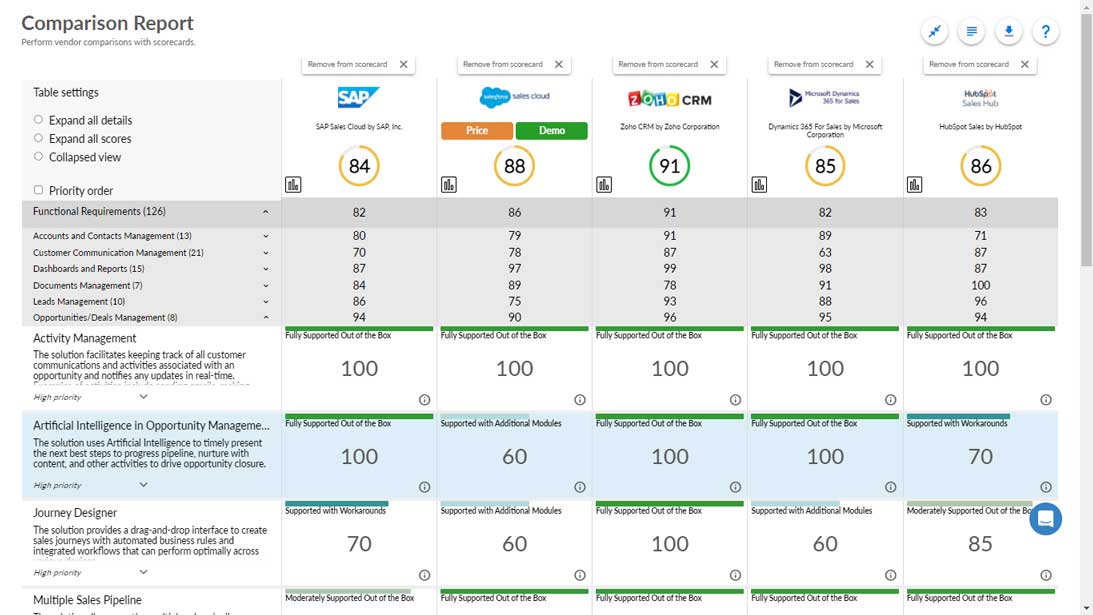
With a clear grasp of CRM Software Pricing Comparison: A Comprehensive Guide, you can approach the CRM selection process with confidence and insight. By weighing features, costs, and long-term value, your business can sidestep hidden pitfalls and secure a CRM solution that supports growth, efficiency, and a strong bottom line. The right CRM pricing plan is not just a cost—it’s an investment in your organization’s future success.
FAQ Guide
What is the average cost of CRM software?
The average cost of CRM software varies widely, ranging from free basic plans to over $100 per user per month for advanced packages. Most small to midsize businesses spend between $12 and $50 per user monthly.
Can CRM pricing be negotiated with vendors?
Yes, CRM pricing is often negotiable, especially for larger contracts or long-term commitments. Negotiation can include discounts, extended trials, or added services.
What features typically increase CRM software costs?
Advanced analytics, custom integrations, automation features, premium support, and increased storage are common features that drive up CRM pricing.
Are there free CRM solutions that work for growing businesses?
Free CRM solutions can support startups and small teams but often lack scalability, advanced features, and comprehensive support as your business grows.
Do all CRM vendors charge for onboarding and data migration?
No, some vendors include onboarding or data migration in certain plans, but many charge extra, so it’s important to clarify these costs upfront.

